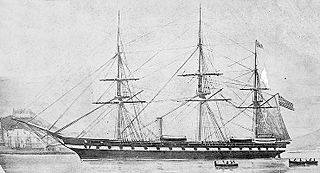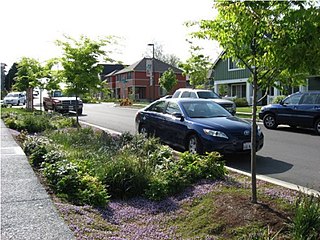
A green roof or living roof is a roof of a building that is partially or completely covered with vegetation and a growing medium, planted over a waterproofing membrane. It may also include additional layers such as a root barrier and drainage and irrigation systems. Container gardens on roofs, where plants are maintained in pots, are not generally considered to be true green roofs, although this is debated. Rooftop ponds are another form of green roofs which are used to treat greywater. Vegetation, soil, drainage layer, roof barrier and irrigation system constitute green roof.
USS Agamenticus was one of four Miantonomoh-class monitors built for the United States Navy during the American Civil War. Commissioned as the war was ending in May 1865, the ironclad saw no combat and was decommissioned in September and placed in reserve. The ship was reactivated in 1870, having been renamed Terror the previous year, and was assigned to the North Atlantic Fleet where she served in the Caribbean Sea. The monitor was decommissioned again in 1872 and was sold for scrap two years later. The Navy Department evaded the Congressional refusal to order new ships by claiming that the Civil War-era ship was being repaired while building a new monitor of the same name.

A roof garden is a garden on the roof of a building. Besides the decorative benefit, roof plantings may provide food, temperature control, hydrological benefits, architectural enhancement, habitats or corridors for wildlife, recreational opportunities, and in large scale it may even have ecological benefits. The practice of cultivating food on the rooftop of buildings is sometimes referred to as rooftop farming. Rooftop farming is usually done using green roof, hydroponics, aeroponics or air-dynaponics systems or container gardens.

Urban agriculture,urban farming, or urban gardening is the practice of cultivating, processing, and distributing food in or around urban areas. Urban agriculture is also the term used for animal husbandry, aquaculture, urban beekeeping, and horticulture. These activities occur in peri-urban areas as well. Peri-urban agriculture may have different characteristics.

Fort Greene is a neighborhood in the northwestern part of the New York City borough of Brooklyn. The neighborhood is bounded by Flushing Avenue and the Brooklyn Navy Yard to the north, Flatbush Avenue Extension and Downtown Brooklyn to the west, Atlantic Avenue and Prospect Heights to the south, and Vanderbilt Avenue and Clinton Hill to the east. The Fort Greene Historic District is listed on the New York State Registry and on the National Register of Historic Places, and is a New York City designated historic district.

New York City Emergency Management (NYCEM) was originally formed in 1996 as part of the Mayor's Office under Rudolph W. Giuliani. By a vote of city residents in 2001 it became an independent agency, headed by the commissioner of emergency management. In 2006 the office was reorganized under the deputy mayor for administration by Mayor Michael Bloomberg.

USS Roanoke was a wooden-hulled Merrimack-class screw frigate built for the United States Navy in the mid-1850s. She served as flagship of the Home Squadron in the late 1850s and captured several Confederate ships after the start of the American Civil War in 1861. The ship was converted into an ironclad monitor during 1862–63; the first ship with more than two gun turrets in history. Her conversion was not very successful as she rolled excessively and the weight of her armor and turrets strained her hull. Her deep draft meant that she could not operate off shallow Confederate ports and she was relegated to harbor defense at Hampton Roads, Virginia for the duration of the war. Roanoke was placed reserve after the war and sold for scrap in 1883.

Sustainable drainage systems are a collection of water management practices that aim to align modern drainage systems with natural water processes. SuDS efforts make urban drainage systems more compatible with components of the natural water cycle such as storm surge overflows, soil percolation, and bio-filtration. These efforts hope to mitigate the effect human development has had or may have on the natural water cycle, particularly surface runoff and water pollution trends. SuDS have become popular in recent decades as our understanding of how urban development affects natural environments, as well as concern for climate change and sustainability, have increased. SuDS often use built components that mimic natural features in order to integrate urban drainage systems into the natural drainage systems or a site as efficiently and quickly as possible. SUDS infrastructure has become a large part of the Blue-Green Cities demonstration project in Newcastle-upon-Tyne.

Steiner Studios is a film studio at Brooklyn Navy Yard in Brooklyn, New York City. It is the largest film and television production studio complex in the United States outside Hollywood. Steiner Studios, spread across 20 acres (8.1 ha), contains 17 soundstages as well as additional support space.

Green infrastructure or blue-green infrastructure refers to a network that provides the “ingredients” for solving urban and climatic challenges by building with nature. The main components of this approach include stormwater management, climate adaptation, the reduction of heat stress, increasing biodiversity, food production, better air quality, sustainable energy production, clean water, and healthy soils, as well as more anthropocentric functions, such as increased quality of life through recreation and the provision of shade and shelter in and around towns and cities. Green infrastructure also serves to provide an ecological framework for social, economic, and environmental health of the surroundings.
Rooftop Films is a non-profit film organization based in Gowanus, Brooklyn. It is best known for its Rooftop Films Summer Series, a film festival that runs from May through August every year, and consists of as many as 47 outdoor screenings of new independent short and feature-length films. Rooftop screenings all take place on rooftops or in other outdoor locations throughout New York City. Rooftop also offers film and video equipment rentals throughout the year, as well as grants which help finance new independent film projects.

Admiral's Row was a row of ten homes formerly used by naval officers in the New York City borough of Brooklyn at the Brooklyn Navy Yard, and owned by the National Guard of the United States. The houses were built between 1864 and 1901.

In New York City, there is an extensive water supply system that supports several programs and infrastructure pertaining to the city's food supply. City officials, agencies, and organizations cooperate with rural farmers to grow food more locally, as well as protect waterways in the New York metropolitan area. The New York City Department of Education operates a school-time and summertime breakfast/lunch program. However, New York City is also deprived of supermarkets in several neighborhoods, and the city has combatted this issue by allowing extra street vendors to operate in the city. To encourage food safety, New York City also has a restaurant-grading system that it introduced in 2010. Because of its various food programs, New York City has become a model for food systems internationally.

The Brooklyn Navy Yard is a shipyard and industrial complex located in northwest Brooklyn in New York City, New York. The Navy Yard is located on the East River in Wallabout Bay, a semicircular bend of the river across from Corlears Hook in Manhattan. It is bounded by Navy Street to the west, Flushing Avenue to the south, Kent Avenue to the east, and the East River on the north. The site, which covers 225.15 acres (91.11 ha), is listed on the National Register of Historic Places.
New York Sun Works, founded in 2004 by Ted Caplow, is a non-profit organization that uses hydroponic farming technology to educate students and teachers about the science of sustainability. To further this goal, NY Sun Works created the Greenhouse Project, an initiative dedicated to improving K through 12 grade environmental science education through the lens of urban agriculture, empowering children to make educated choices about their impact on the environment. The Greenhouse Project was inspired by NY Sun Works’ first project, the renowned Science Barge; a prototype, sustainable urban farm and environmental education center previously housed on the Hudson River and now located in Yonkers under different ownership.

Brooklyn Bowl is a music venue, bowling alley and restaurant in the Williamsburg neighborhood of Brooklyn, New York. Founded in 2009, it is located in the former Hecla Iron Works Building at 61 Wythe Avenue. It is known for its high-tech green construction and variety of musical acts. In 2013 Rolling Stone named Brooklyn Bowl the 20th best music club in the United States.

The South Brooklyn Marine Terminal (SBMT) is an intermodal shipping, warehousing, and manufacturing complex in the Port of New York and New Jersey. It is located along the Upper New York Bay, between 29th and 39th Streets in the Sunset Park and Greenwood Heights neighborhoods of Brooklyn, New York City. The site is adjacent to Bush Terminal and Industry City, which respectively lie directly to the south and east. A recycling and waste transfer facility managed by Sims Metal Management is the major tenant. In May 2018, the city contracted partners to activate the largely unused terminal.

Broadway Stages, Ltd. is one of New York’s full-service film and television production companies, with its headquarters in Greenpoint, Brooklyn. Broadway Stages’ studios can be found throughout Brooklyn, Queens and Staten Island. As of 2018 it has over 3 million square feet of integrated space including soundstages, locations, production services and parking.
East New York Farms! (ENYF) is a community organization created to address food justice issues in the East New York neighborhood of Brooklyn, New York.
Gotham Greens is an American fresh food and urban agricultural company founded and headquartered in the Brooklyn borough of New York City, that grows local produce year-round in greenhouses, with its lettuces, herbs, salad dressings and sauces sold under its brand name. The company owns and operates nine hydroponic greenhouse facilities in the United States.

















